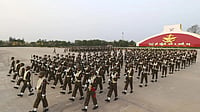The Archaeological Survey of India (ASI) in its latest report on the controversial Gyanvapi Mosque Survey, mentioned the ‘existence of a large temple’ before the mosque. “There existed a large Hindu temple before the construction of the existing structure” in the 17th century, the ASI mentioned in its extensive report after citing an in-depth study of the existing structure. And with this, the unit is once again in the eye of a storm over what it presents and how it leads to communal tension.
The All-India Muslim Personal Law Board (AIMPLB) executive member Qasim Rasool Ilyas said the ASI report is not “conclusive evidence” in this controversial case. “By doing this, the opposition party (Hindu side) has created a feeling of anarchy and insecurity in the society,” he said, while also accusing the Hindu side of “insulting” the court by releasing the ASI report in the media.
“Hindu communal organisations have been misleading the public for many years regarding the Gyanvapi Masjid. The latest example is the ASI report which they filed in court and made available to the plaintiff and defendant only on court orders,” he said.
History has invariably influenced the shape of modern nation-states. And the past has always had a bearing on the present political ideologies. More than often, ASI has found itself drawn into this clash of ideologies, being at the centre of controversies and criticism—most of them hurled by political opponents of the ruling BJP at the Centre.
Founded in 1861 by the British, the ASI, whose record history has been the discovery and subsequent excavation of the ruins of Mohenjo-Daro since the mid-19th century, has been embroiled in many such controversies.
In 2022, archaeologist KK Muhammad, who claims to be the first person to witness the remains of a temple under the Babri Masjid in Ayodhya, alleged that post-2014, the Archaeological Survey of India (ASI) became "a wholly paralysed body". The claim that was made in a book was strongly rebutted by former Union culture minister Mahesh Sharma.
The archaeologist has also alleged that when the saffron party came to power in 2014, it reduced the financial powers of the superintending archaeologists from Rs 25 lakh to Rs 3 lakh, due to which they could not carry out any conservation work of monuments and temples and looked at the head office in Delhi for every little thing.
Government experts, who were part of the decision to reduce the financial powers of the superintending archaeologists, said it was done with “good intent to bring accountability” among the engineers and archaeologists and later on, when it was realised that it did not work out, the decision was reversed.
However, that has not altered the situation for ASI when it comes to findings that lead the way for demolition.
On August 22, the ASI submitted a 574-page report to the Lucknow bench of the Allahabad High Court on its excavations in Ayodhya to verify claims about a Hindu temple beneath the then-destroyed Babri Masjid. Critics and a section of the archaeological community were aghast at the ASI’s rush to submit its report which was compiled within 10 days of the completion of the survey on August 12.
In an earlier report by Outlook, ASI experts explained how political games have a strong influence over the body’s method of functioning. Former employees of the ASI, Outlook had earlier spoken to say that the organisation has been under pressure from all governments. According to one of them who retired over a decade ago, the organisation has been strongly influenced by the political classes that emerged post-1947. “After this period, the pressure increased and the brief was for findings connected to ethnicity and religion. There was a clash between archaeological research and ground reality. This has continued,” he says.
This is probably the only department whose investigations and findings create tensions, says a former ASI director-general. “There is a close link between religion and archaeology and the ASI is helping establish it,” he adds.
The demolition of the Tughlakabad slums, surrounding the historic Tughlakabad Fort, rendering over 2,00,000 people homeless had ASI’s role to be played. In January 2023, the ASI declared that construction in the area was illegal and that it was an archaeological site. Initially, the residents were asked to vacate the area by January 26. But later, the judiciary gave them temporary relief with a stay on the demolition order. However, this did not last long, and within a span of three months, on April 26, a notice came the citizen’s way declaring that all the houses in the area would be razed within four weeks. The ASI now plans to build a 3-km-long boundary wall to protect the historic area from further encroachment.
However, the ASI, which is also entrusted with conserving historic monuments, has been able to copy and preserve more than 74,000 inscriptions. Yet the popular perception of the ASI has been increasingly that of a slothful bureaucratic machine bereft of any innovative spirit.
Earlier, in 2018, the Supreme Court had pulled ASI up over not taking appropriate steps to protect the Taj Mahal, notwithstanding the dirt and pollution in the city of Agra, where the monument is located. The court was irate enough to have asked the government representative whether the ASI should be shut down.
Further, in the face of a section of Hindu-right wings claiming the origin of Taj Mahal, in 2022, the ASI put up in public domain photographs of the sealed rooms in the Taj Mahal premises to scotch speculations after Hindu groups demanded their reopening to look for possible signs of Hindu heritage.
Some ASI officials, however, do not deny that there is “more pressure” on them as the right wing seeks to revisit and reconstruct history from the Hindu viewpoint. In the earlier report of Outlook, a source from ASI (on request of anonymity), said, “The Ministry of culture, the parent body of the ASI, is focused on excavations at sites built by the Mughals because it believes that these were Hindu religious sites before. The ASI is the tool to deliver.” The ASI is caught in a quagmire of political, social and nationalistic pressures, says a source who has followed the shifting ideologies of the organisation over the years. “There was pressure when the Congress held power at the Centre, but in the present government’s politics, the ASI is playing an important role,” a former head of the ASI told Outlook.
According to a report by PTI, a section of senior archaeologists has also alleged an autocratic and over-centralised administrative setup in the ASI. In 2022, K K Muhammed summed up the seven years of the BJP government and said, "This period would go down in the history of the ASI as the most unfortunate period during which all those who imposed these toilet complexes knew the cost of toilets and cafeterias but not the value of temples and monuments."
In a recent development, advocate Vishnu Shankar Jain of the Hindu side in the Gyanvapi case said that Hindus have been allowed by a Varanasi court to offer prayers at 'Vyas Ka Tekhana' or the basement of the mosque premises. According to the court order, prayers could be conducted by priests from the Vishwanath Temple and arrangements should be made to remove barricades blocking entry into the Gyanvapi mosque's basement, which was sealed on the order of the Supreme Court during the ASI survey.


























